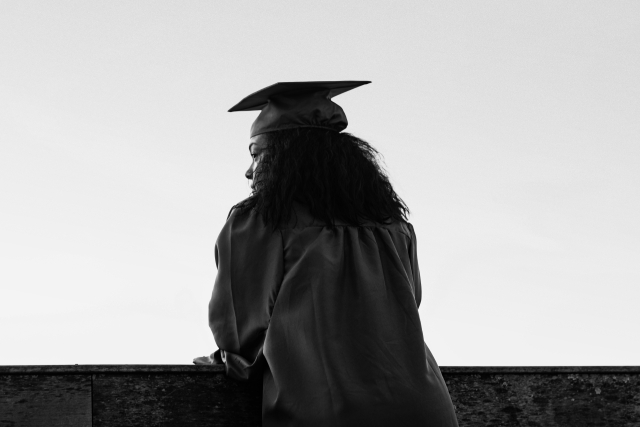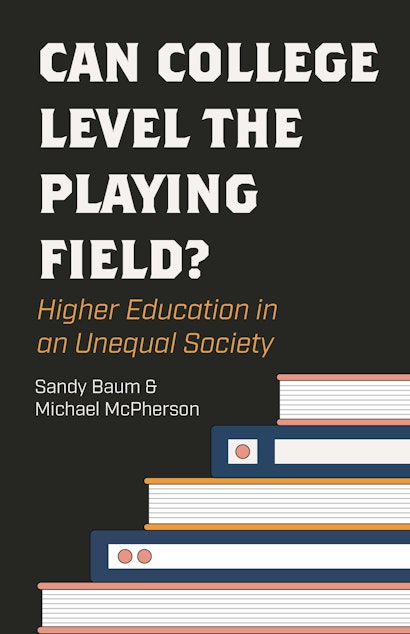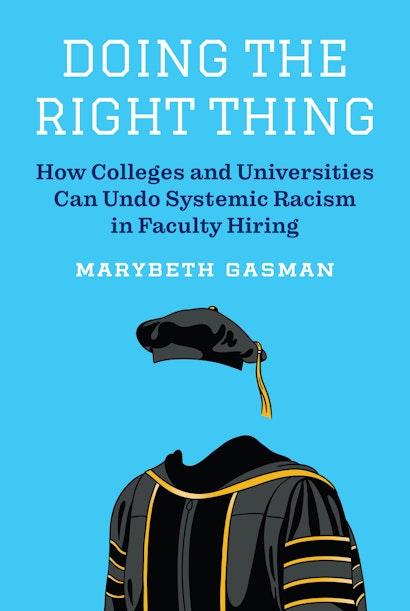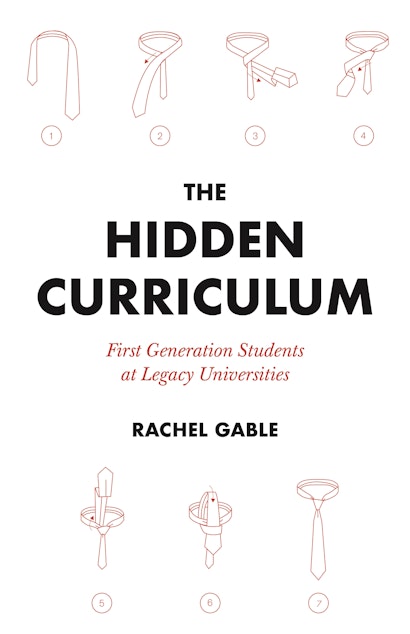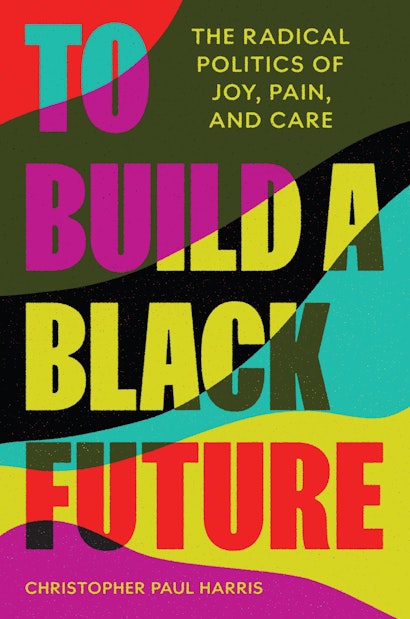With the first round of early decision deadlines happening this month, it’s a good time to reflect on the realm of higher education and its evolving dynamics, including the multifaceted nature of equitable and inclusive education. This month’s In Dialogue addresses a pertinent question in the wake of a recent Supreme Court ruling on Affirmative Action in college admissions: How do college environments benefit from racial diversity, and can colleges achieve it without Affirmative Action? We asked four of our authors with expertise in the intersections between academia, social sciences, and education to delve into the issue. Their responses reflect the complexities surrounding diversity within educational institutions.
Sandy Baum and Michael McPherson | Can College Level the Playing Field?: Higher Education in an Unequal Society
Creating more diverse environments in colleges and universities across multiple dimensions of diversity would be a good thing. It would be even better to take steps aimed at ensuring that children grew up and went to school in more diverse environments from the get-go, but that is not a matter which the higher education system itself can do much to control. The plain fact, though, is that affirmative action, from its inception during Lyndon Johnson’s presidency, has not had diversity as its principal objective.
Rather the main goal of affirmative action has always been to make an effort, even if only a modest one, to overcome the great historical injustice our nation has imposed on Black people, captured in Africa and dragged to this continent in ships to serve the white population as slaves. Other great injustices, against Native Americans, against women, and against other ethnic minorities, might also be repaired in some small measure by affirmative action. No one has better articulated this nation’s need for affirmative action than President Lyndon B. Johnson:
“You do not take a person who, for years, has been hobbled by chains and liberate him, bring him up to the starting line of a race and then say, ‘You are free to compete with all the others,’ and still justly believe that you have been completely fair.”[1]
“The plain fact, though, is that affirmative action, from its inception during Lyndon Johnson’s presidency, has not had diversity as its principal objective.”
However, since the 1978 Supreme Court decision in the Bakke case, courts have not allowed arguments about historical injustice. From then on, the only permissible defenses for affirmative action have been those grounded in the aim of promoting diversity. This decision was, in our view, and more importantly, in the view of many distinguished legal scholars,[2] a mistake, one which has produced an unbalanced defense of affirmative action in college admissions, and placed an undue burden on the argument for the value of diversity itself, which should not have been tasked with carrying the full weight of the case for affirmative action alone.
In the 2003 Grutter vs Bollinger case, Supreme Court Justice Sandra Day O’Connor opined that in 25 years affirmative action would no longer be necessary. No one knows what she actually had in mind with this somewhat gnomic statement, which was not integrated into her main argument. Perhaps it was simply a pious hope, but it could well have been read as a call to action. Maybe, had we started right away, back in 2003, we could have made a good beginning on an ambitious national effort to overcome the appalling inequalities in housing, in neighborhood conditions, and in educational opportunities from early education through high school that plague this nation. O’Connor’s thought might have been that a quarter-century of sustained effort on these fundamental inequalities could erase, or at least dramatically attenuate, the gaps in qualifications across racial and socioeconomic groups at the time of college admission. By now, twenty years after Grutter, we might have been closing in on that outcome.
Our recent Princeton University Press book, Can College Level the Playing Field? (2022), includes a thorough review of existing inequalities in pre-college opportunity. Despite sporadic and sometimes instructive efforts at improvement, the inequalities facing children born into different circumstances remain shocking. If Justice O’Connor was indeed issuing a call to action, it has so far gone unheeded.
The continuing imperative to attempt to partially compensate for past injustices that continue to profoundly influence the lives of so many Americans does not negate the value of diversity on elite college campuses (which are the only ones where affirmative action plays a significant role). These institutions can and must make every effort to enroll student bodies from diverse racial, ethnic, and socioeconomic backgrounds. But these colleges and universities, along with the rest of our society, must also work to diminish the inequalities facing potential students long before they apply for college.
Marybeth Gasman | Doing the Right Thing: How Colleges and Universities Can Undo Systematic Racism in Faculty Hiring
Diversity of all kinds is what makes society, and higher education excellent. Yet, what I know from my personal experience as well as from my research is that those working at institutions of higher education must be incentivized to pursue racial diversity at both the student (and faculty levels) – especially within the nation’s most selective colleges and universities.
In recent decades, institutions of higher education have increased diversity in enrollment at the undergraduate level. For example, between 1975 and 2016, the population of college undergraduates changed significantly, with increases across most racial and ethnic groups. Hispanic student enrollment has increased from 4% to 18%, Black student enrollment from 10% to 14%, Asian American and Pacific Islander enrollment from 2% to 7%, and Native American enrollment from 0.7% to 0.8%. At some of the nation’s highly selective institutions, the percentage of undergraduate students of color has increased substantially, and high standards of quality have remained intact. For example, Columbia University, New York University, and Stanford University have student bodies comprised of over 65% students of color. And, Northwestern University and the University of Chicago have student bodies comprised of roughly 55% students of color.[3] Racial and ethnic diversification has advanced in undergraduate student populations across the country due to the implementation of affirmative action – or more specifically, by considering race and ethnicity as one factor in college admissions.
“…will the next legal challenge be focused on the life experiences of people of color?”
It is important to note, however, that most of the students of color at highly selective universities are from middle- and upper-income families. The percentage of Pell Grant–eligible students, a marker of low-income status, ranges from 13% to 21% at the nation’s most selective institutions, which are considerably low figures. Nation-wide, 40% of undergraduate students receive Pell Grants overall. For comparison’s sake, at Historically Black Colleges and Universities, a staggering 71% of students are Pell Grant eligible.
There are considerable wealth gaps in the U.S. with the nation’s white families holding $124.5 trillion in assets as compared to Black families with $8 trillion, Hispanic families with $5.5 trillion, and all other racial and ethnic groups combined hold $15.7 trillion in assets. Moreover, according the U.S. Census, “white families had a median household wealth of $187,300, compared with $14,100 for Black householders and $31,700 for Hispanic householders. Asian householders had a median household wealth of $206,400.” This lack of access to wealth on the part of people of color translates to a lack of access to expensive standardized test preparation courses, high schools with dual enrollment and Advanced Placement courses, internships, and the extracurricular activities that are prized by highly selective colleges and universities.
The use of race as one factor in admissions, especially at highly selective colleges and universities, has enabled incredibly talented students of color to gain access to these institutions and the education – and social capital – that they provide. With the Supreme Court’s recent decision to ban the use of race in admissions decisions, the one glimmer of hope left for equitably diversifying America’s most selective institutions is Chief Justice John Robert’s caveat in the Court’s Opinion: “… nothing prohibits universities from considering an applicant’s discussion of how race affected the applicant’s life, so long as that discussion is concretely tied to a quality of character or unique ability that the particular applicant can contribute to the university.” Although these words don’t address systemic inequities that have existed since the beginning of our nation, they do allow admissions officers room to craft a class that brings unique perspectives and talents. However, the question remains: If colleges and universities take Robert’s at his word and consider life experiences related to race as a factor in college admissions, will the next legal challenge be focused on the life experiences of people of color? Will the courts be filled with lawsuits that focus on the individual experiences (and struggles), broadly defined of students and whether they are worthy of college admission? My hunch is that this is where we are heading in our shortsightedness around the power of diversity in our colleges and universities.
Rachel Gable | The Hidden Curriculum: First Generation Students at Legacy Universities
So much of the college experience—from selecting courses and majors to allocating time for friends and extracurriculars—revolves around the poet Mary Oliver’s enduring inquiry: what is it you plan to do with your one wild and precious life? I am routinely struck by the hunger and passion that the students I encounter display as they pursue a worthy and well-lived life. Not just employment and an enviable income, but a good life, one that entails quality friendships and community and the meaningful pursuit of one’s vocation. At the same time, the public discussion of what college is good for has narrowed to equating graduate success with earnings, and worse, to assume that the best universities are engaged in a competitive struggle over maximizing the percentage of graduates whose incomes place them in the top 1% of the U.S. financial hierarchy. This is an absurd distortion of what higher education can and should do for society. And unfortunately, this absurd distortion has swept the worthy goal of racial diversity in higher education into mammon’s maelstrom.
“Now is the time for elite institutions to start thinking creatively about serving a much larger number of racially and economically diverse students — not simply by diversifying their relatively small undergraduate classes.”
I have collected hundreds of interviews over more than a decade with students from first-generation and rural backgrounds, as well as those from privileged and legacy families. These interviews explore their experiences in choosing and then navigating both elite and non-elite institutions. Some of this research is detailed in my book, The Hidden Curriculum: First-Generation Students at Legacy Universities. What strikes me the most is the paramount value that college students place on diversity as both an end in itself and as a means to a more enriched, fulfilled life. Many have shared how exposure to diverse peers enhanced their college experience and provided lifelong friendships they never imagined possible. Often, the students who emphasized the importance of diversity and of spaces where they could explore diverse identities were not of the identity group they chose to participate in while in college. A low-income Latino student from Houston made a home among a Black Men’s group comprised mostly of Black students from wealthier East and West Coast families, and they helped him master the study skills he needed to succeed in college. A Black student from the rural South made her closest friends in the Vietnamese Students Association. A Chinese American student changed her career trajectory after participating in an African dance troupe. A rural White student, who had never left her home state prior to college, found her academic passion while living in the international dorm among students from all over the world, eventually studying abroad in multiple countries. Their stories highlighted the life-altering, perspective-changing experiences that result from valuing and embracing diversity, as these students had while actively and respectfully exploring identity-based communities different than their own.
The media conversation around the end of affirmative action in college admissions seems to focus almost exclusively on the role that elite colleges play in educating our nation’s leadership class and on propelling their graduates into the highest paid jobs. I routinely hear pundits and experts speak of the value of diversity among institutions that cater to the 1%, as if our nation’s critical problems can be solved if we only diversify our most privileged class rather than critiquing why that privileged class continues to reap excessive rewards at the expense of the middle and working classes. We are made to assume that elite institutions play an outsized role in educating the next generation of leaders across a range of professions because these institutions boast the highest density of high-performing students—that is, their student bodies comprise the meritocratic winners of a high school academic achievement contest. But by the overall volume of high-performing students, this assumption is not quite true. Research shows that top high school achievers tend to select colleges based on geographic and financial constraint, and that social class is a stronger predictor than high school performance in determining whether a student will attend a highly selective college. Most often, top students choose a college they think is likely to admit them that is both affordable and somewhat close to home. If our goal as a nation is to diversify corporate C-suites, government agencies, academia, and the media, then one simple solution may lie in reducing the emphasis on recruiting for these kinds of jobs at elite institutions; instead, we should cultivate a diverse pool of candidates from colleges and universities across the country, most of which serve diverse student bodies.
The end of affirmative action for elite admissions doesn’t have to deal a vital blow to the goal of diversifying leadership in our society. I see two directions for colleges and universities to take now that the Supreme Court has ended affirmative action in admissions. First, we should stop presuming that the academically meritorious students are only found at elite colleges and start spending more time cultivating pipelines for leadership among high-performing students attending a wide range of colleges across the U.S. And second, elite colleges can start seriously considering ways to expand access to their undeniably valuable libraries, laboratories, and academic resources. This can be achieved through stronger partnerships with community colleges, strengthened transfer pathways, and more robust opportunities for non-degree seeking students (such as those matriculated elsewhere) to spend short periods of time in concentrated study on their campuses. The National Science Foundation’s Research Experience for Undergraduates (REU) programs offers a model for this, as faculty and laboratories at universities across the country invite high-performing students from a wide range of colleges to join them for a summer of paid research and mentorship in a specific field that students from less resourced colleges may never be able to access otherwise. Now is the time for elite institutions to start thinking creatively about serving a much larger number of racially and economically diverse students — not simply by diversifying their relatively small undergraduate classes. The end goal here is greater access to the benefits of a fulfilling vocation and a life well-lived, not merely a shot at the 1%.
Christopher Paul Harris | To Build a Black Future: The Radical Politics of Joy, Pain, and Care
I’d like to briefly disentangle “affirmative action” from “racial diversity” initiatives. This will allow us to raise questions about the ideological underpinnings of each and challenge some of their normative assumptions — assumptions that are, innocently enough, evident in the nature of the question asked here. But first, let me tip my hand and indicate where I’m headed, which is toward political horizons. Whether we’re talking about colleges, Congress, or the Supreme Court itself, the question should not be how the institutions we’ve created benefit from recognizing and accommodating racial diversity. By doing so, we concede too much in favor of these institutions and consequently sequester where our imagination might otherwise wander. After all, racial diversity is an objective social fact with a history steeped in exploitation and racial violence, elements that are structurally embedded in these same, purportedly sacrosanct institutions. And this remains the case regardless of the degree of apparent surface-level changes or the policy infrastructure designed to facilitate them. More pointedly, this fact persists even though that same policy infrastructure is openly under attack by the conservative majority (and their wealthy patrons) of the unelected and lifetime-appointed members of the Supreme Court, one of the pillars of our “democracy.” What I’m highlighting here is that racial diversity, as an objective social fact, should not require justification, not least in a subordinated position to centuries-old structures whose continued legitimacy is, to put it mildly, a matter of debate.
So, what might we ask instead? What should our starting point be? Before I go too far down that road, let’s return to racial diversity and affirmative action. Though different, they are overlapping articulations of the same normative assumption that, despite being well-intended, do not challenge the primary ideological presuppositions we operate under, and therefore hinder our ability to shift the frame of our political horizon. In other words, they do not trouble capitalism and the atomizing nature of its neoliberal phase.
“… racial diversity, as an objective social fact, should not require justification, not least in a subordinated position to centuries-old structures whose continued legitimacy is, to put it mildly, a matter of debate.”
In the decades following John F. Kennedy’s initial executive order advocating “affirmative action” to advance equal workplace opportunities for the historically excluded, there has been a notable expansion of “equal opportunity” in both its meaning and application. At their best, these efforts explicitly acknowledge and seek to remedy historically discriminatory (and often violent) exclusions through an array of policy directives across different sectors of society, including within higher education. Despite their differences, these directives are typically quantitative and designed as temporary solutions. Consequently, even as it operates, or has operated, under the assumption that the state has an affirmative role to play in ensuring equal economic access for all (either through a job or through education as a pathway to one) – essentially, endorsing everyone’s contribution to and potential benefit from capitalism – affirmative action was always limited in its scope and intended duration.
Furthermore, this approach to equal opportunity perpetrated a notion of the common good that masked the flaws inherent in American liberal democracy’s system of individuation, exploitation, and subjection, along with its attendant institutions, including colleges, Congress, and the Supreme Court. The constraints of such a system are evident, but beyond what I’ve already laid out, I’ll simply note that it leaves affirmative action, and the good things it has accomplished in the everyday material lives of portions of the traditionally excluded (e.g., expanded access to the economy and therefore survival), susceptible to opposing or reactionary stances, as evidenced in this year’s Supreme Court rulings. As a result, we’re left fighting for policies that were already deficient, leading not only to policy setbacks but also a stifled imagination. To put it another way, our political horizon narrows when struggling on a terrain defined by those opposing its very existence.
Broadly speaking, diversity, as a clearly articulated and, for the moment at least, constitutionally protected goal of, or adjacent to, affirmative action policy, has a parallel yet differing objective. The present ubiquity of “diversity, equity, and inclusion” (DEI) programs in higher education is evidence of how widely accepted that objective has become. If affirmative action aims to quantitatively diversify workplace demographics, diversity programs developed a more qualitative hue. Demographic change, the thinking goes, was only the first step, albeit a necessary one. It wasn’t just about altering the makeup of an institution but also its inherent culture. The goal was to allow racial diversity to shape, for example, a college classroom, a curriculum, a campus, rather than simply inserting a diverse array of people into existing structures without substantive change.
In that sense, though largely voluntary rather than mandated by law or executive action, diversity efforts have arguably been attempts to posit diversity, in and of itself, as a normative good beyond being an objective social fact; one that can and should be realized by effectively augmenting our institutions in both form (who has access) and content (the experience that this access yields), recognizing their past history of exclusion and erasure. Accordingly, diversity programs extend beyond the more conditional and temporary goals of affirmative action in a comparatively productive way. Nevertheless, they still fall victim to a similar trap: the pursuit of diversity does not directly challenge our underlying system of individuation, exploitation, and subjection, a system intrinsically tied to the very institutions that diversity programs aim to improve.
To be clear, I don’t oppose viewing diversity as a normative good or seeing it as a worthy goal for colleges and other institutions. I also acknowledge the tangible benefits that affirmative action has produced for the traditionally excluded and recognize its foundational role in spurring the present wave of diversity initiatives. My contention lies in the perception of diversity as a normative good and an end in itself. This perspective fails to diagnose, or even critically engage the structural problems and the objective social facts at the heart of the matter. It suggests a desire to nurture well-rounded individuals who have been exposed to diverse perspectives and experiences, which will make them better equipped to productively contribute to a “multicultural” capitalist society. Such a perspective might reshape our institutions without ever truly challenging their foundational ideals, or even the premises of capitalism itself. Institutions like colleges, Congress, and the Supreme Court, along with their purported aims, are seldom scrutinized to determine whether they truly align with our wishes or if we want their current incarnations. Despite appearances, the social is subordinated to our normative assumptions about our institutions, secondary to the stories we’ve told ourselves and passed on. Such positioning reflects both a limited political imagination and an already circumscribed political horizon evidenced in the kinds of questions we’re willing to ask.
So again, what might an alternative starting point be?
In a world where we are permitted, and where we permit ourselves, to begin with the social—placing a racially diverse collective before and above the individual—we might ask whether and how our institutions benefit the common good; not as an abstraction, but from the perspective of the material conditions under which most people live. We might ask to what extent these man-made institutions, often perceived as if divinely conceived, are even capable of doing so given their history. We might ask after who and what our institutions serve, in their deeds rather than simply their rhetoric; and, just as importantly, we might ask to what end. And if we do that, if those are our questions, and we end up with answers we don’t like, we might then ask, what should we create instead.
Sandy Baum is a nonresident senior fellow at the Center on Education Data and Policy at the Urban Institute and professor emerita of economics at Skidmore College. Her books include Student Debt. Michael McPherson is president emeritus of the Spencer Foundation and Macalester College. His books include Lesson Plan (Princeton).
Marybeth Gasman is the Samuel DeWitt Proctor Endowed Chair & a Distinguished University Professor at Rutgers University. She is the author of Doing the Right Thing: How Colleges and Universities Can Undo Systemic Racism in Faculty Hiring.
Rachel Gable is the director of academic program authorization at William & Mary and holds a doctorate in education from Harvard University. She lives in Richmond, Virginia.
Christopher Paul Harris is an Assistant Professor in the Department of Global and International Studies at the University of California, Irvine. His research interests range from Black political thought, culture, aesthetics, and social movements to broader questions concerning the possibility of revolutionary transformation in the 21st century. Advancing an abolitionist critique of the capitalist world system, his work aims to understand the political lives, thought, and cultures of the Black diaspora and the underlying social forces that shape them. His first book is To Build a Black Future: The Radical Politics of Joy, Pain, and Care, which draws on his own experiences as an activist and organizer to take readers inside the Movement for Black Lives (M4BL) against the backdrop of the centuries-long Black freedom struggle.
This exchange was facilitated by Yutong Li, Social Impact Fellow.
Notes
[1] Lyndon Johnson ( 1965), Howard University Commencement Address, The American Yawp Reader, https://www.americanyawp.com/reader/27-the-sixties/lyndon-johnson-howard-university-commencement-address-1965/
[2] See, for example, Laurence Tribe, “Perspectives on Bakke: Equal Protection, Procedural Fairness, or Structural Justice,” 92 Harv. L. Rev. 864 (1978-1979); Ronald Dworkin (2002). “What did Bakke Really Decide?” chapter 16 in The Affirmative Action Debate, ed. Steven C. Cahn, Routledge.
[3] UCLA and UC-Berkeley boast undergraduate populations comprised of over 70% students of color. However, due to attacks on affirmative action in the state, Black and Latinx students are underrepresented.
